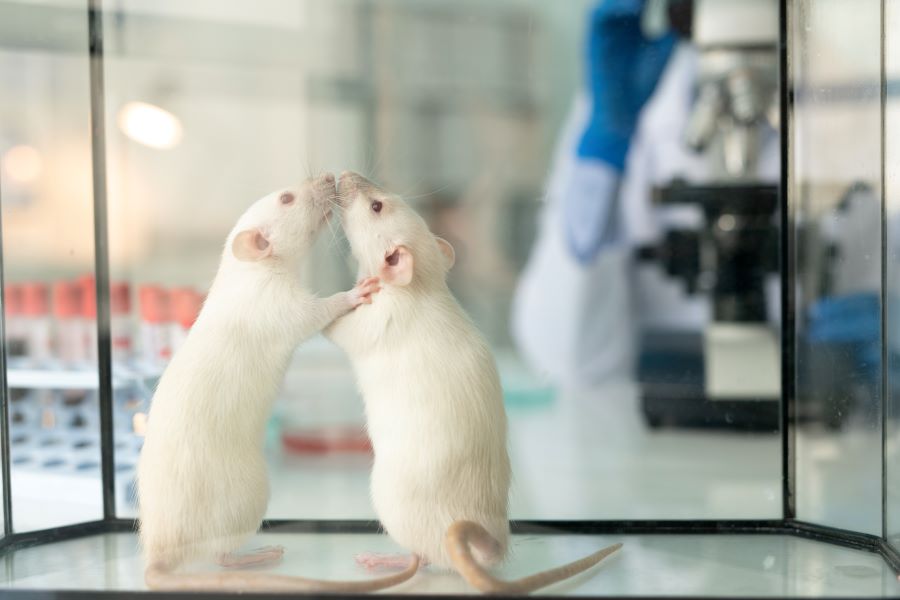Tradition vs. progress: The ethics of animal use in nutrition science
PETA scientist calls out ethical biases and outdated assumptions in human nutrition research

Much of scientific nutrition research still relies on animal testing practices, which are rooted in tradition. However, modern technologies that do not rely on animal lives are much more accurate and relevant to human biology and are not subject to human judgment on animal suffering.
Nutrition Insight asks People for the Ethical Treatment of Animals (PETA) why research continues to use this outdated approach when better alternatives are available and how institutions regurgitate ethical biases — choosing convenience over life.
Emily R. Trunnell, Ph.D., director of Science Advancement and Outreach, Laboratory Investigations Department, tells us about the biggest scientific misconceptions sustaining industry’s reliance on animal testing.
“The use of animals in human nutrition research is largely based on the false assumption that results from experiments on animals can translate to humans. There are clear species differences that thwart this translation.”
She points to the human gastrointestinal (GI) system as an example, which is different from many species used in animal experiments. “Rats have no gallbladder or cystic duct, and pigs differ in the regulation and release of important gut hormones compared to humans.”
“Humans are one of the only species that cannot produce vitamin C endogenously, and the gut microbiome can vary widely between different animal vendors or in laboratories kept at different temperatures, inconsistencies that are exponential when considering different species,” she says. “There are many more differences.”
Cannot equate animal to human responses
Trunnell states that animal models cannot replicate the mixed bowel responses seen in irritable bowel syndrome (IBS) or the genetic and environmental factors contributing to the human condition.
 Emily R. Trunnell, Ph.D., director of Science Advancement and Outreach, Laboratory Investigations Department at PETA.“Compounding this is the reality that certain aspects of GI disorders and upset — such as abdominal pain, anxiety, and depression — are fundamentally impossible to accurately study in non-human animals.”
Emily R. Trunnell, Ph.D., director of Science Advancement and Outreach, Laboratory Investigations Department at PETA.“Compounding this is the reality that certain aspects of GI disorders and upset — such as abdominal pain, anxiety, and depression — are fundamentally impossible to accurately study in non-human animals.”
“The use of animals is also based on inertia and convenience,” she adds. “Animal experimentation is centuries-old and complex non-animal methods (NAMs) are comparatively much younger. This means older scientists were trained before many of the human-based models available today were even invented.”
Ph.D. mentors trained in animal use will pass on the practice and skill to the next generation, leading to more animal-based literature to build on and compare findings. Trunnell highlights this practice skews new research pathways.
“It doesn’t help that many nutrition journals have very lax policies on publishing experiments on animals. Many animals — like mice — are also unfortunately cheap and seen as disposable.”
Bet on combined human-based models
Critics may argue that animal-free methods are not yet ready for complex nutrition studies. However, Trunnell counters that various human-relevant models are already used in nutrition research.
“The question is really why scientists are continuing to use models that don’t reflect human biology just because they’re more ‘complex,’” questions Trunnell. “Other animals may be a ‘whole model,’ but they’re the wrong ‘whole model’ if the aim is to understand humans.”
“A successful path forward will involve the coordinated use of multiple models — in vitro human systems, computational biology, and other forms of human data. For complex studies, no one model will give the full picture, but a combination of human-based models will provide more useful data than an animal model ever could.”
Harnessing tech for ethical practice
Trunnell points out that instead of using animals, experiments could be done on humans, especially when foods and nutrients being tested are already present in our diets, making it safe to study.
 Human intestine-on-chip system (Image credit: Food Frontiers).“When those studies are impossible for ethical or practical reasons, human in vitro models are valuable tools,” Trunnell suggests. “Using patient-derived induced pluripotent stem cells can provide personalized information on responses to nutrients and therapeutics and can be used to create 3D organoids and organ-on-a-chip models.”
Human intestine-on-chip system (Image credit: Food Frontiers).“When those studies are impossible for ethical or practical reasons, human in vitro models are valuable tools,” Trunnell suggests. “Using patient-derived induced pluripotent stem cells can provide personalized information on responses to nutrients and therapeutics and can be used to create 3D organoids and organ-on-a-chip models.”
“Primary cells and cell lines from different human tissues have been used to make organoids to model human adipose, stomach, intestinal, liver, and kidney tissue, as well as parts of the nervous system.”
She details that organs-on-chips, also known as microfluidic platforms, can model the human stomach, gut, liver, pancreas, immune system, adipose tissue, brain, and blood-brain barrier.
“Omics approaches, including genomics, transcriptomics, metabolomics, proteomics, epigenomics, lipidomics, microbiomics, and combinations of these (multi-omics), are more powerful than ever, allowing researchers to study large amounts of molecular data from individuals or populations,” Trunnell highlights.
“Computational modeling using AI is augmenting all of these methodologies and also being used to create ‘digital twins’ to transform and personalize patient care.”
“Tradition doesn’t trump improvement”
The US National Institutes of Health (NIH) recently announced it will not promote animal-only research, but will support human-based research methods via funding. We ask Trunnell what this shift may require from scientists.
 Animal experiments in nutrition often rely on outdated assumptions, despite clear biological differences that limit their relevance to humans.“I am a big proponent of giving scientists the best possible resources to facilitate their transition away from animal models and toward human-based research. One step is to expand funding and training in non-animal approaches, which NIH has already vowed to do.”
Animal experiments in nutrition often rely on outdated assumptions, despite clear biological differences that limit their relevance to humans.“I am a big proponent of giving scientists the best possible resources to facilitate their transition away from animal models and toward human-based research. One step is to expand funding and training in non-animal approaches, which NIH has already vowed to do.”
“NIH and other funders should also provide animal experimenters with a safety net during this transition — financial support while training to use non-animal methods, purchasing any new equipment they might need, and building new collaborations,” she suggests.
Trunnell notes that some scientists may resist switching to NAMs because they might feel less “productive,” that is, they might publish fewer papers during retraining. This is why they need support from their university administration.
“Others may worry that shifting to better methods will reflect poorly on their past work, but when you know better, you have to do better. Tradition doesn’t trump improvement.”
NIH deputy director Dr. Nicole Kleinstreuer stated they are developing long-term solutions to prevent new animal labs from opening when old ones close — creating “actual permanence in this space.”
Bias in ethical board
Trunnell argues that institutional ethics boards, which approve animal use and create norms and systems, shape the culture of research more than people realize.
“I often refer to Institutional Animal Care and Use Committees (IACUCs) and other institutional oversight bodies as the last line of defense for animals in laboratories.”
“Because they are primarily composed of other animal experimenters, they’re biased toward the use of animals and lack sufficient expertise to know whether a study proposing to use animals could actually be done in humans or with human-relevant methodologies.”
Last week, Nutrition Insight spoke to Jarrod Bailey, Ph.D., director of Medical Research, Physicians Committee for Responsible Medicine, about scientists’ faith in IACUCs’ ethical review and its unnecessary cost. For instance, thousands of rats and mice were recently killed to prove the well-known fact that pulses are good for humans.
Trunnell explains that IACUCs are not required to judge whether animal tests are needed. Instead, they are tasked to ensure animal experiments are carried out, meeting minimal requirements of animal care outlined in the Animal Welfare Act. “They often fail miserably at that.”
“But because they exist, the public is left with a false impression that experiments on animals are under stringent oversight and would not be conducted unless absolutely necessary,” she underscores. “A cursory search through recently published animal experiments and facility inspection reports would squash those misconceptions.”
“If nutrition research truly prioritized human relevance, only humans and human data would be used in research design and experiments on animals would be obsolete. It’s really that simple.”












